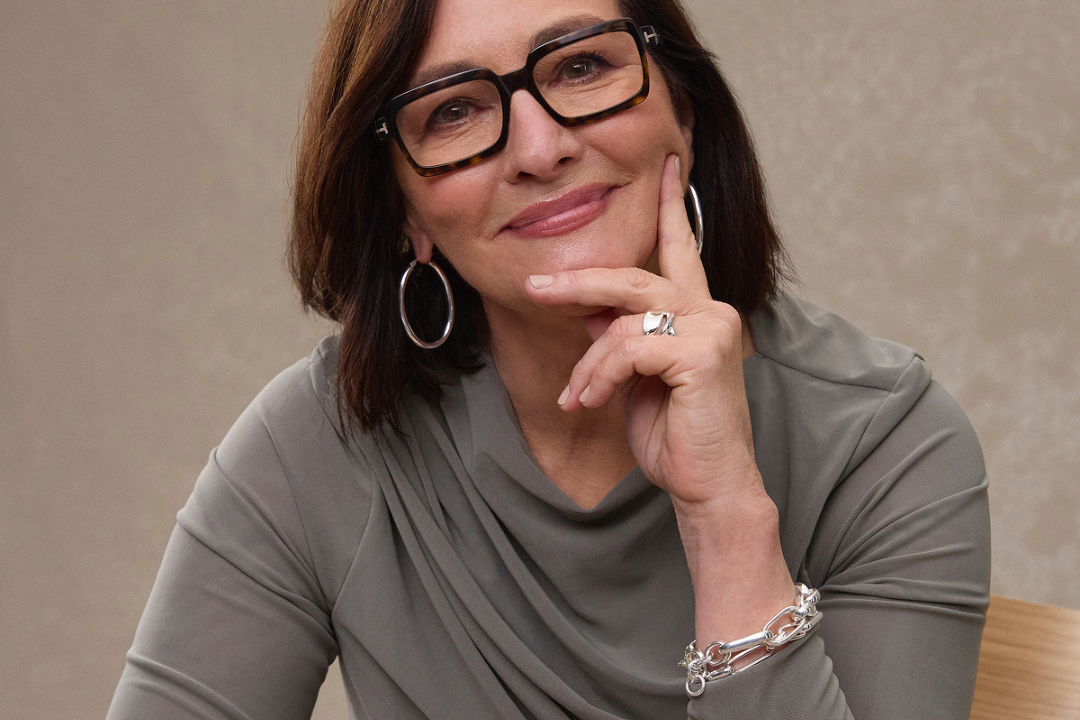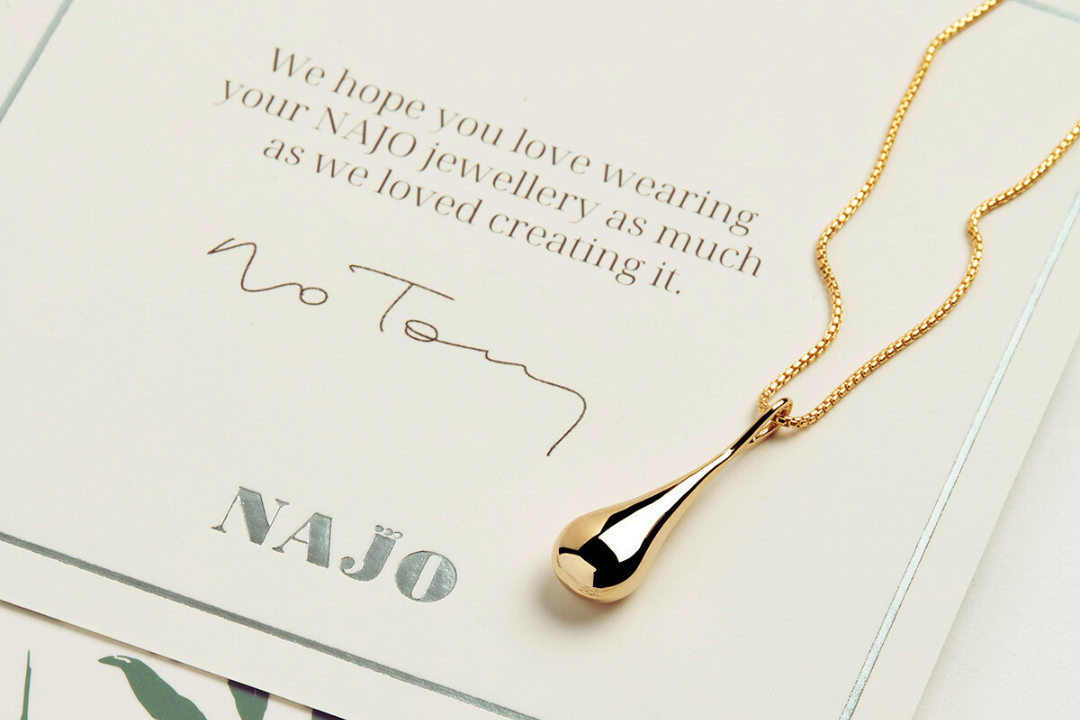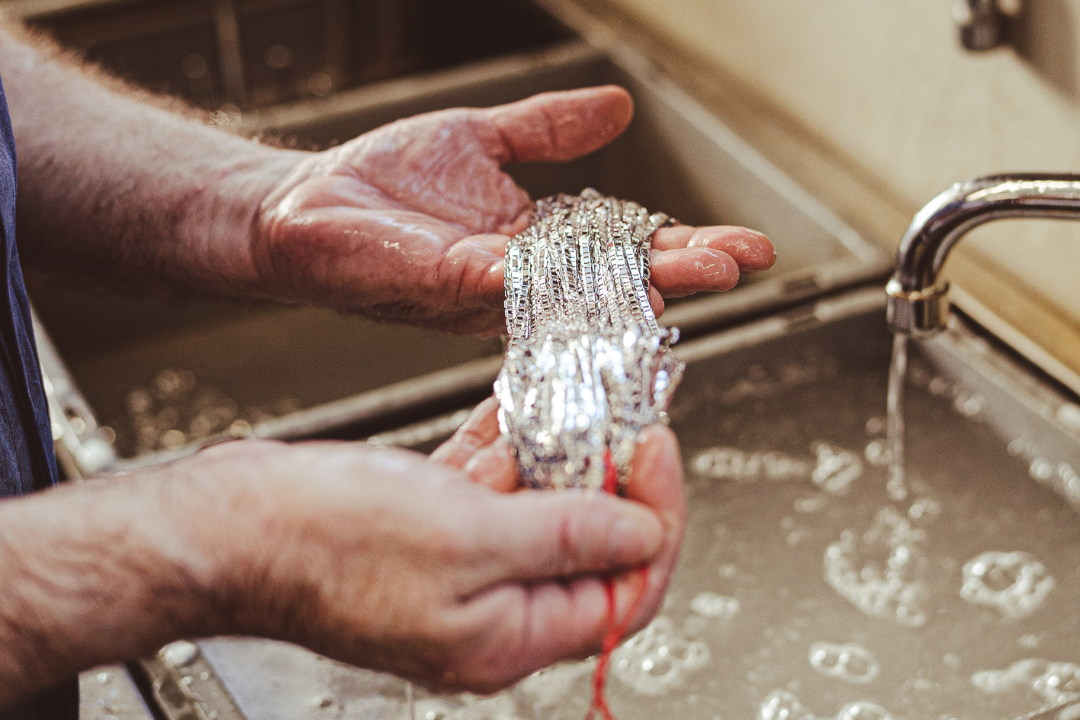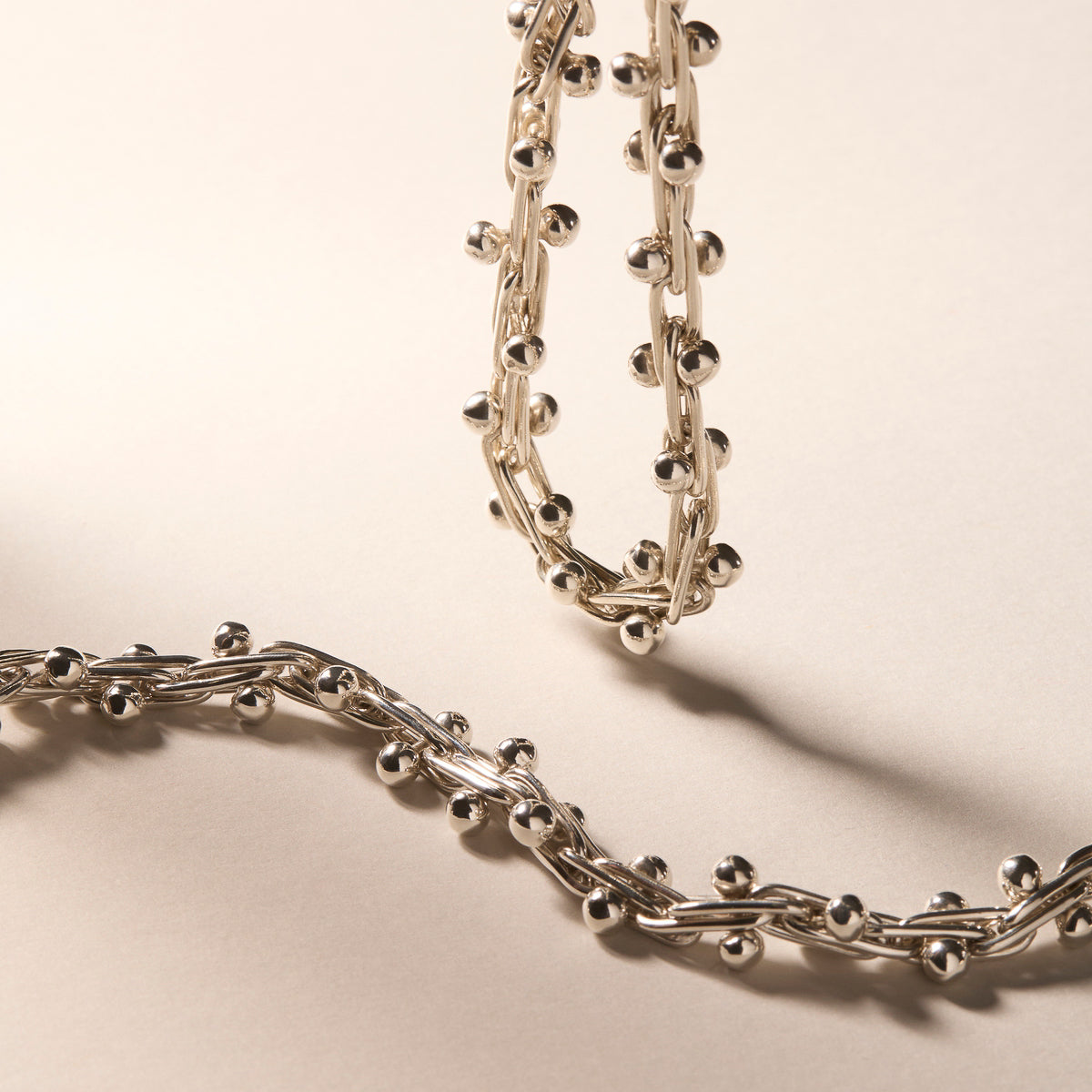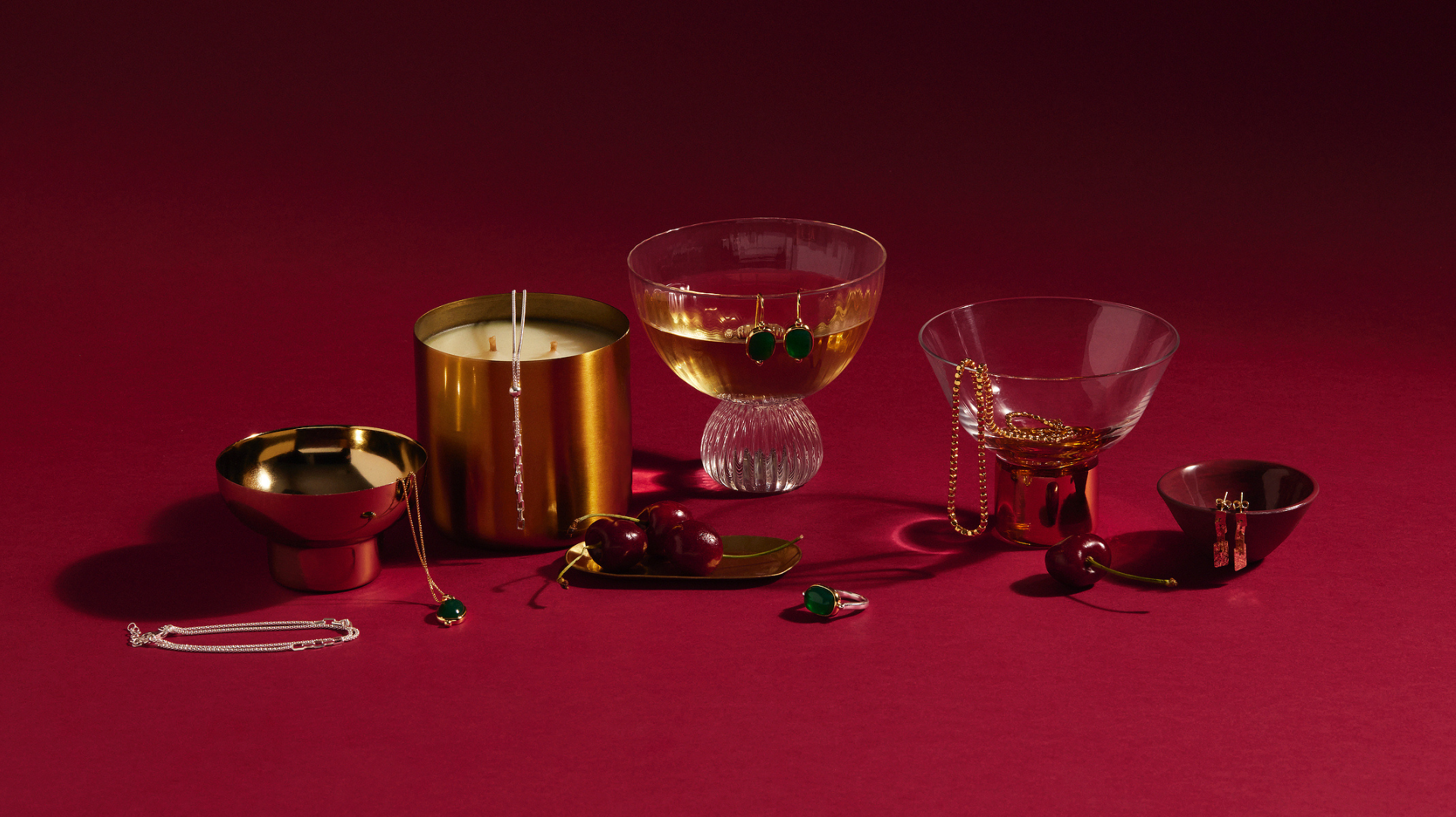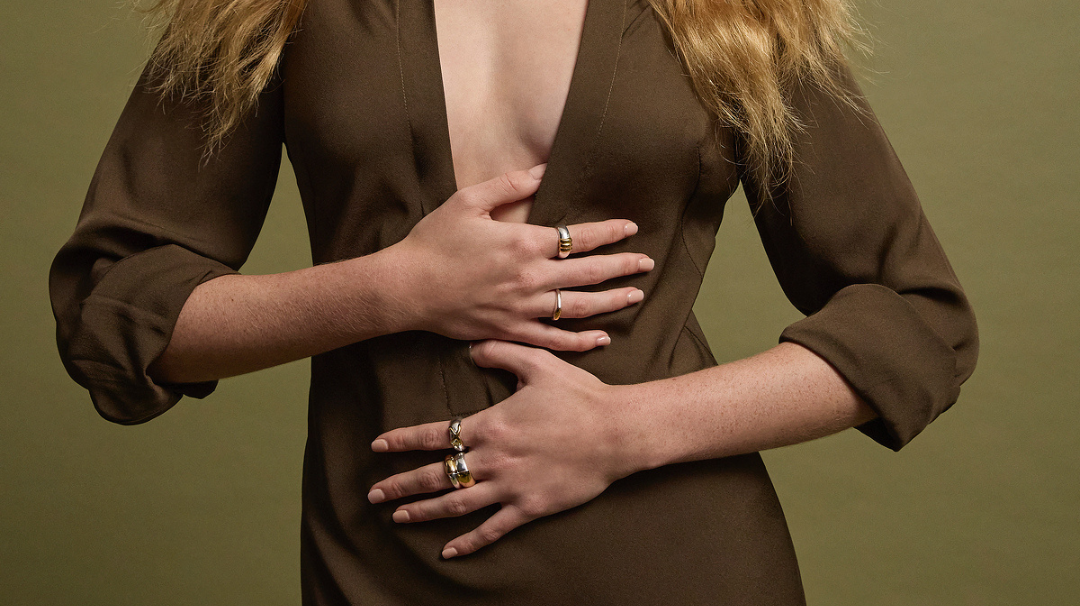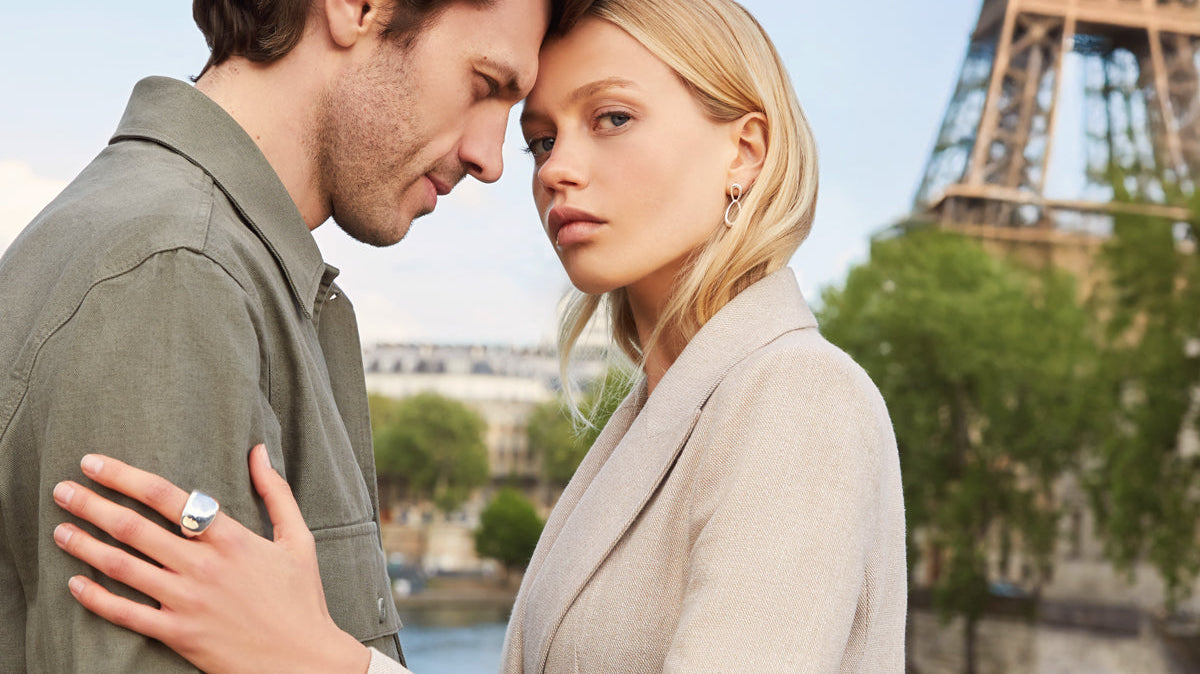What’s the difference between silver and sterling silver?
Sterling silver. This luxurious gleaming precious metal is entwined in our NAJO DNA. But what is sterling silver, and what’s the difference between sterling silver and silver found in Earth’s crust? Get comfy with a cuppa and check out our Definitive Sterling Silver Guide.
It has everything you need to know about sterling silver and why it’s the real silver of choice for jewellers globally. We also explore more about silver in its elemental state, what makes silver sterling and answer your most frequent questions about caring for sterling silver jewellery.
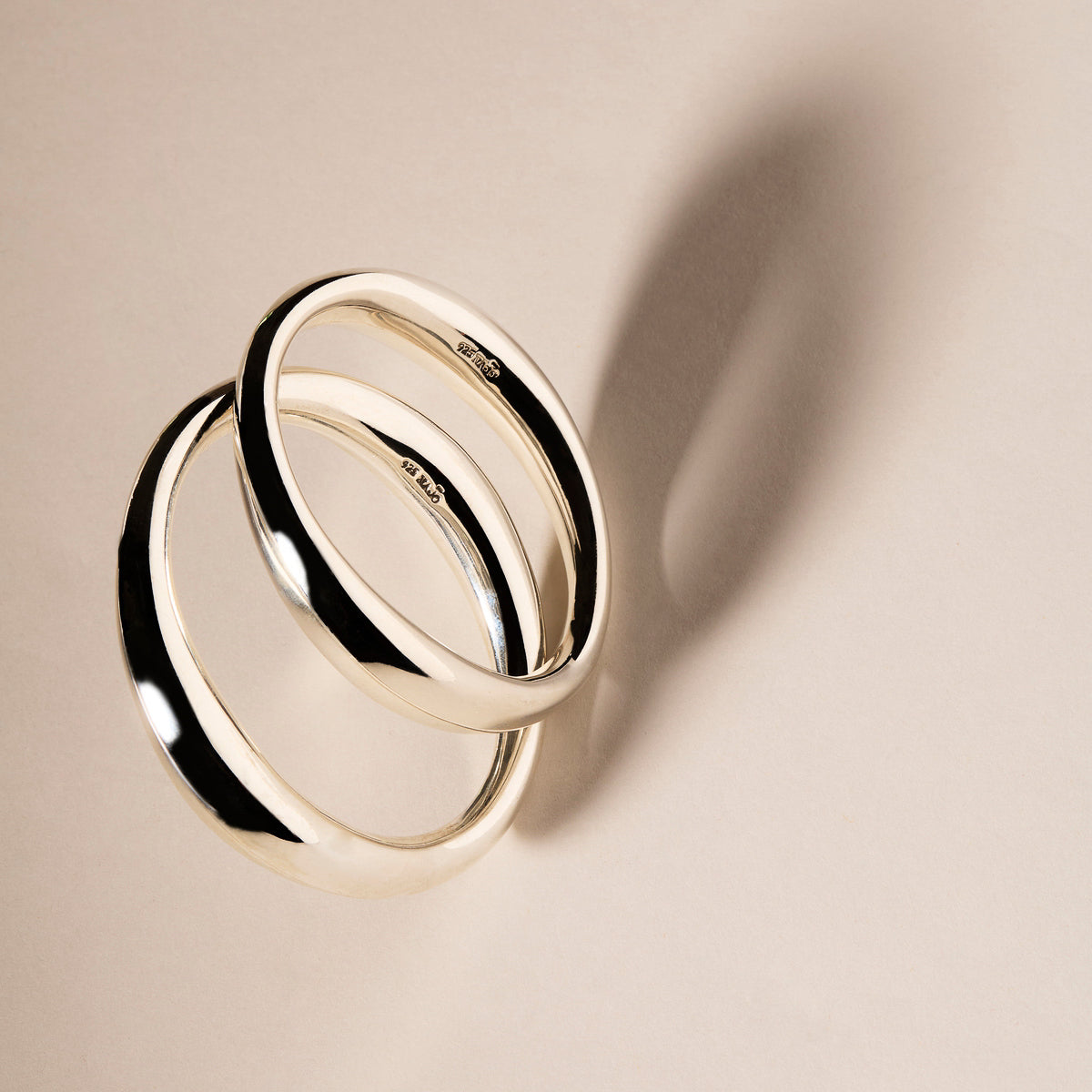
Silver’s elemental properties: Is silver a hard metal?
Surprisingly, no. Silver sits between copper and gold in the Periodic Table of Elements because its character and chemical composition is similar to both.
Silver’s reflectiveness, malleability (ability to be shaped) and ductility (ability to draw it out into a wire or thread without breaking) make it perfect for forming into jewellery. However, just like pure gold, pure silver is considered too soft for jewellery as pieces can scratch, bend and dent with daily wear.
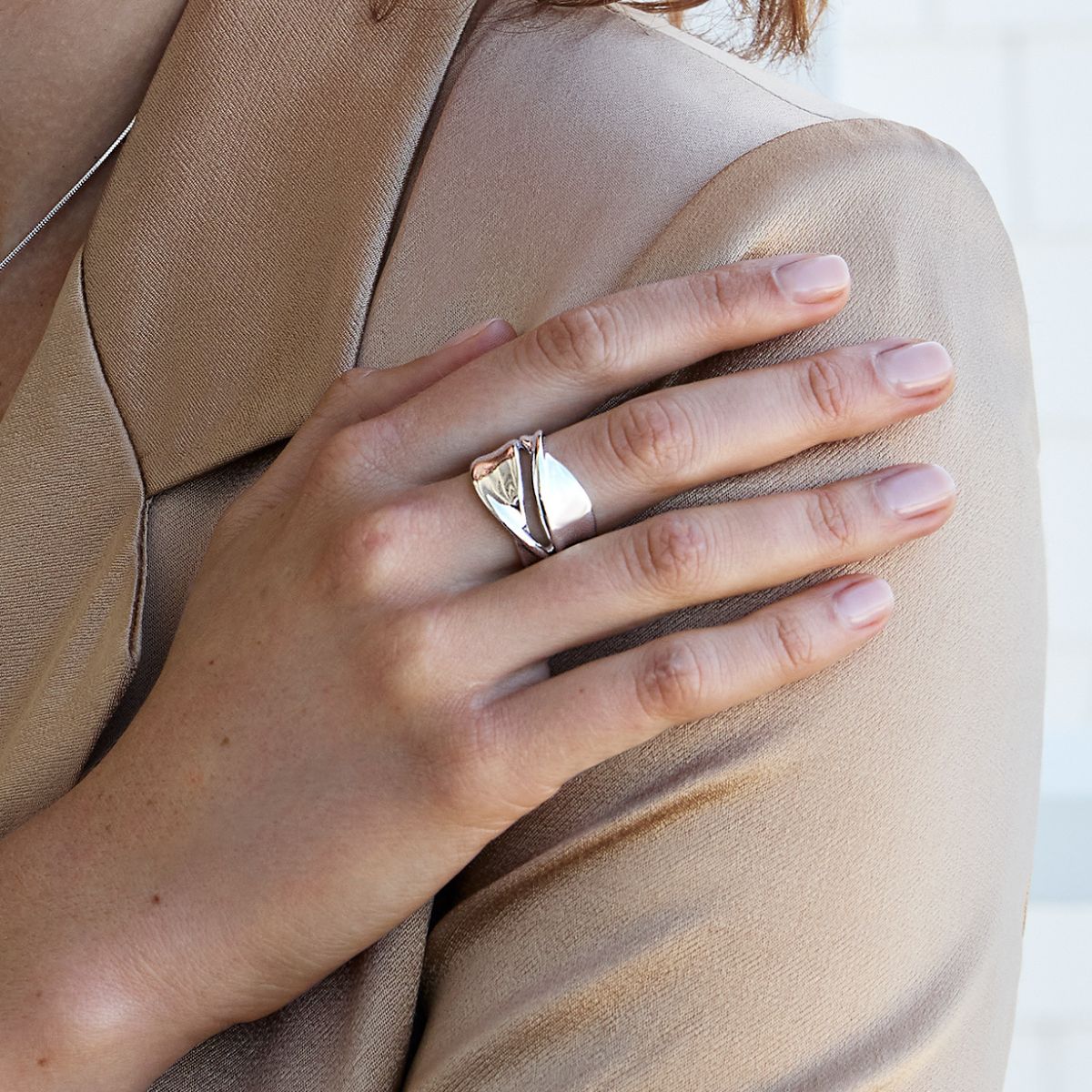
So just how soft is silver used in jewellery today?
It’s actually amazingly strong, thanks to the little addition of another natural element. It’s time to introduce you to the beauty of sterling silver and help you understand the silver vs sterling silver difference.
What is silver? Meet one of Earth’s most lustrous elements!
Silver is a white transition metal highly valued for its unique properties and lustrous beauty. It’s one of the Seven Metals of Antiquity that humans used in prehistoric times and a noble metal with outstanding resistance to oxidation and corrosion.
Essential silver facts and trivia
- Silver’s atomic symbol is Ag from the Latin argentum, meaning silver.
- Pure silver is known as native silver and forms 0.05 part per million of Earth’s crust.
- Silver is one of Earth’s most reflective metals across the visible spectrum, reflecting 95% of light.
- Silver is one of the best electricity conductors. It’s found in almost every electronic device with an on-off button.
- Silver is also essential in the medical world thanks to its antibacterial action.
- Silver is used in many water purifiers as it prevents bacteria and algae from building up in filters.

What is sterling silver?
Sterling silver is an alloy of 92.5% pure silver and 7.5% other metals (usually copper), which adds strength without detracting from silver’s naturally spectacular shine and colour.

And what is better 925 silver or sterling silver?
Sterling silver has been the silver of choice for jewellers and silversmiths for centuries because it’s more durable than pure silver and beautiful to work with.
So if you’ve ever wondered what is better, 925 silver or sterling silver – they’re the same! ‘925’ is the authentication hallmark many jewellers stamp onto their designs to certify the silver is sterling silver of 92.5% purity.
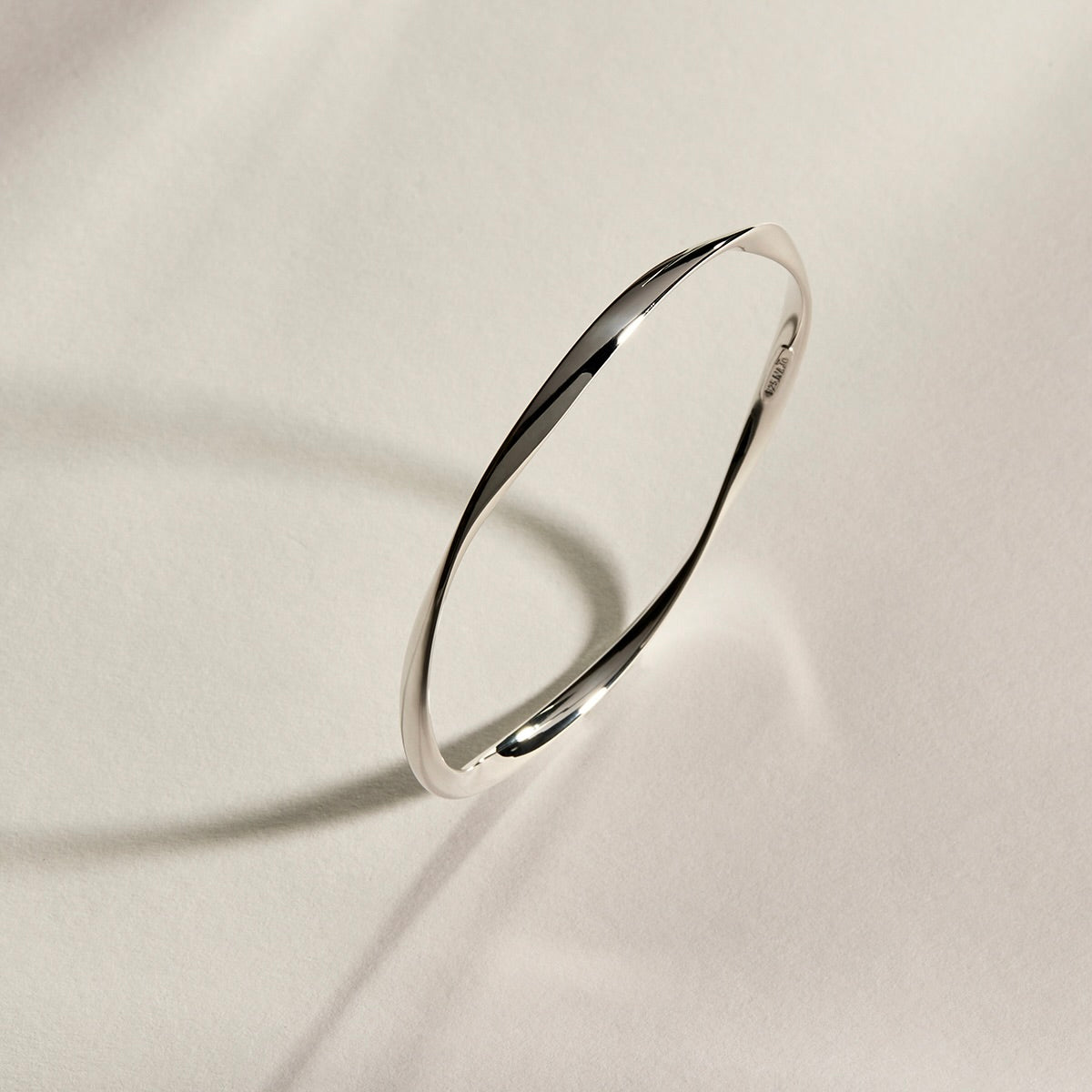
Is sterling silver fake silver?
Wondering is sterling silver real silver? You’re not alone, and we’re happy to confirm it’s real! Silver is graded based on its fineness – to help you understand the difference between fine silver and sterling silver and the purity of sterling silver, we’ve put together a helpful Silver Grades Chart below.
Fine Silver
ALTERNATIVE NAME: .999 silver, FS
AUTHENTICATION HALLMARKS: .999
QUANTITY OF SILVER: 99.9% pure silver, 0.1% trace elements
CHARACTERISTICS: A less popular jewellery silver as it appears greyer and slightly dull and will scratch, dent and change shape easily.
Sterling Silver
ALTERNATIVE NAME: .925 Silver
AUTHENTICATION HALLMARKS: .925, STG, STG SIL, S SIL, STERLING SIL
QUANTITY OF SILVER: 92.5% pure silver, 7.5% other metal (usually copper)
CHARACTERISTICS: Also known as the Sterling Standard. Sterling silver is real silver prized for its quality, affordability, durability, silver colour and lustre.
Coin Silver
ALTERNATIVE NAME: .900 Silver
AUTHENTICATION HALLMARKS: .900
QUANTITY OF SILVER: 90% pure silver, 10% copper
CHARACTERISTICS: A fairly rare type of silver named after the historic melting down of scrap coin metal.
Silver Plated
ALTERNATIVE NAME: None
AUTHENTICATION HALLMARKS: None
QUANTITY OF SILVER: Minimal, measured in micron thickness between 1 and 10.
CHARACTERISTICS: A thin layer of silver plate applied to any type of base metal.

Sterling silver origins and what is .925 silver?
There are many theories surrounding the origin of the word sterling. According to the Oxford English Dictionary, sterling is thought to have originated from the Old English word steorling, meaning coin with a star, because of the stars seen on some Norman pennies.
Many associate the name sterling with the British currency for a good reason. In Anglo-Saxon times, one pound (weight) of silver was formed into 240 pennies. Each penny was made up of 925 parts silver and 75 parts copper. It was thought that Edward I established the term sterling silver as the minimum standard for English silver coinage. To prevent fraud, he sent Guardians of the Craft to shops to test their metals’ ingredients (known as assaying) and check they were using the 925 sterling silver standard (92% pure silver).
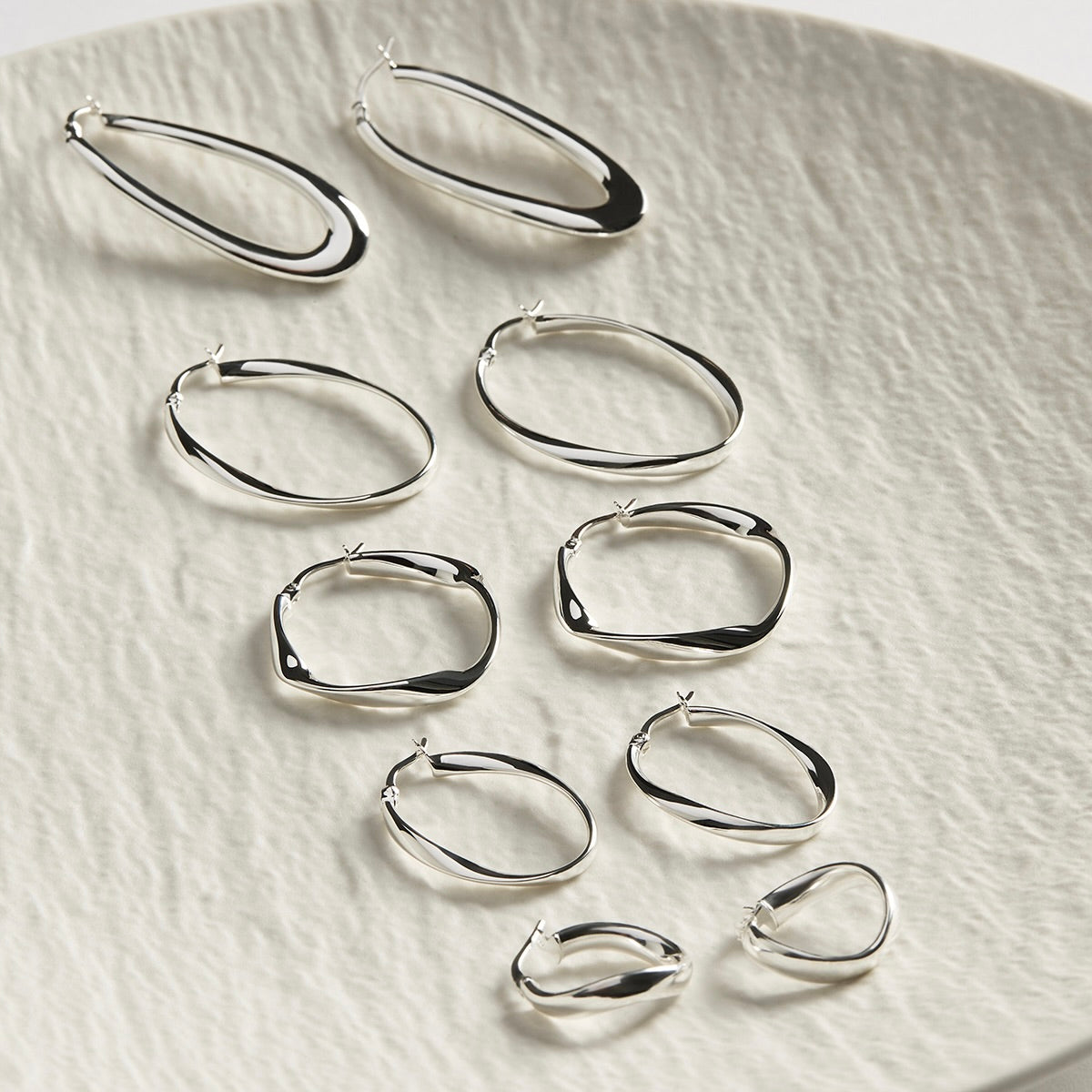
How do you know your jewellery is real silver?
Sterling silver is real silver and precious! But how do you know your jewellery is sterling silver and not an imitation? The easiest way to tell is to examine your jewellery for a stamp known as a hallmark (see our Silver Grades Chart for a list of sterling silver hallmarks). These stamps indicate purity, and you’ll generally find them on the inside of rings, near bracelet and necklace clasps or on the back of your earrings. The ‘925’ sterling silver hallmark is one of the most used and recognised as it represents the 92.5% pure silver content.
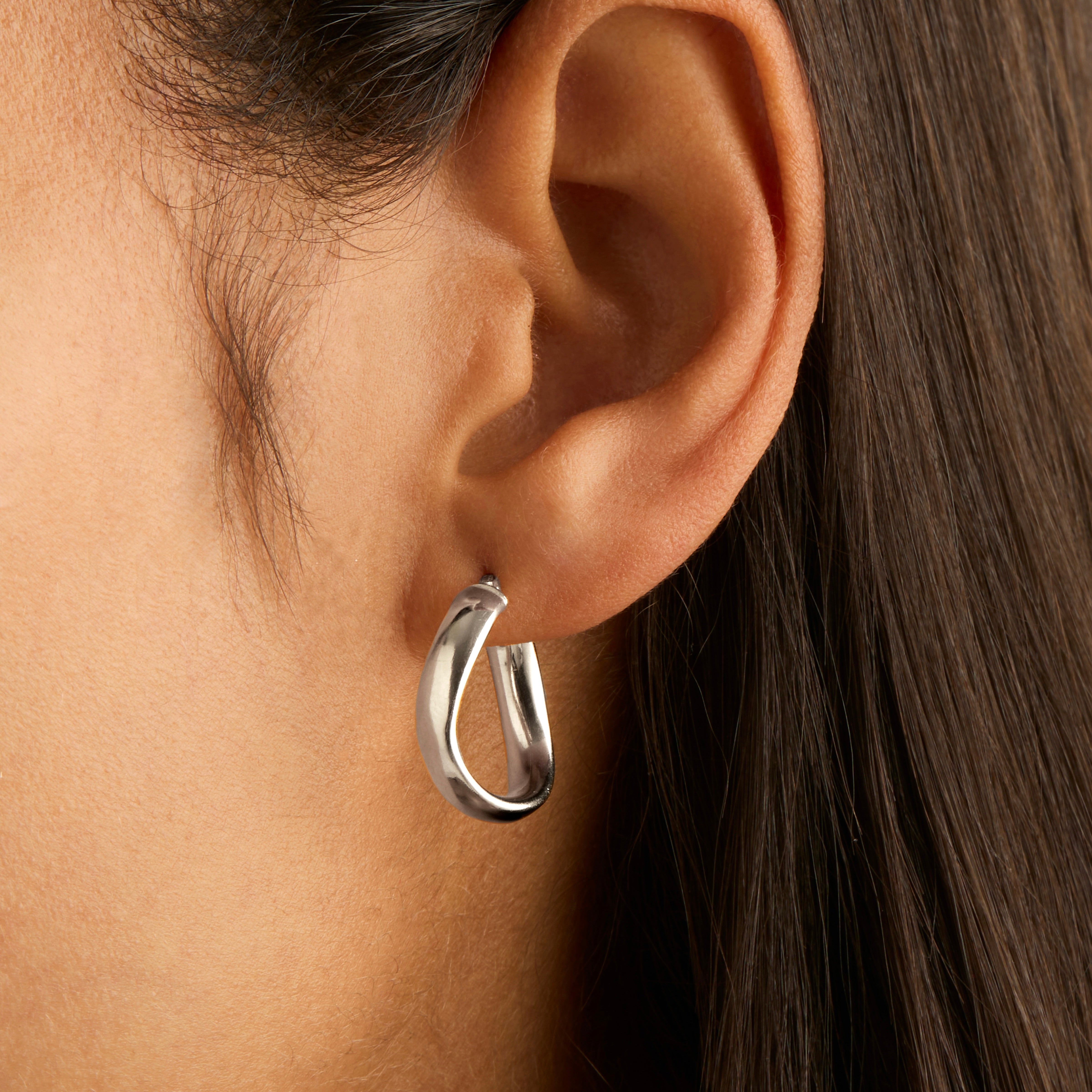
So now you know! If you’ve seen the hallmark on our NAJO pieces and wondered: Does 925 mean sterling silver? And is 925 sterling silver real silver? The answers are yes, and yes! All our NAJO jewellery designs feature the ‘925’ hallmark. In Australia, hallmarking is not required, but we believe it’s best practice to celebrate and certify the high quality and purity of our real sterling silver.
In some cases, jewellers retail their designs as ‘silver’ without hallmarks, making it difficult to know whether the piece you’re purchasing is fake sterling silver, silver plated, or whether there’s any real silver in the piece at all. This wikiHow article has some practical tests to confirm your silver is real silver!
Championing sustainable sterling silver
Contrary to what you might think, just under a third of silver mined is elemental native silver. That’s because silver is present in many naturally occurring ores such as copper, lead and zinc. Most silver we see today is recovered and recycled from residues when refining these other metals. Silver is also recycled from jewellery, silverware and electronic scrap, which closes the loop and creates a sustainable supply.
To uphold our ethos of slow jewellery for sustainable beauty, we craft most of our jewellery using recycled sterling silver sourced from Umicore, a company dedicated to circular materials technology and sustainable value creation.
What lasts longer, silver or sterling silver?
Wondering how long does sterling silver last? Fantastic news! Sterling silver outlives fine silver because, as previously mentioned, it’s an alloy made from 92.5% pure silver and 7.5% copper (and/or other alloys). It’s stronger and more durable than fine silver and can last a lifetime if properly stored and cared for.
How to tell the difference between sterling silver and silver-plated jewellery
Starting out on your silver jewellery journey and unsure how to differentiate sterling silver and silver-plated jewellery? The easiest place to start is the hallmark. If you can’t find one of the hallmarks detailed in our NAJO Silver Grades Chart, ask the jeweller or seller for more information. There are a few key differences between sterling silver and silver-plated jewellery:
- Plated jewellery is often lighter in colour and tone than sterling silver.
- Sterling silver jewellery is usually lighter in weight than silver-plated jewellery (which tends to use a heavier base metal).
- Plated jewellery can irritate those with allergies as the base metal often contains nickel.
All NAJO jewellery is made from 925 sterling silver, including our yellow gold and rose gold plated designs, which use sterling silver as their beautiful high-quality base metal.
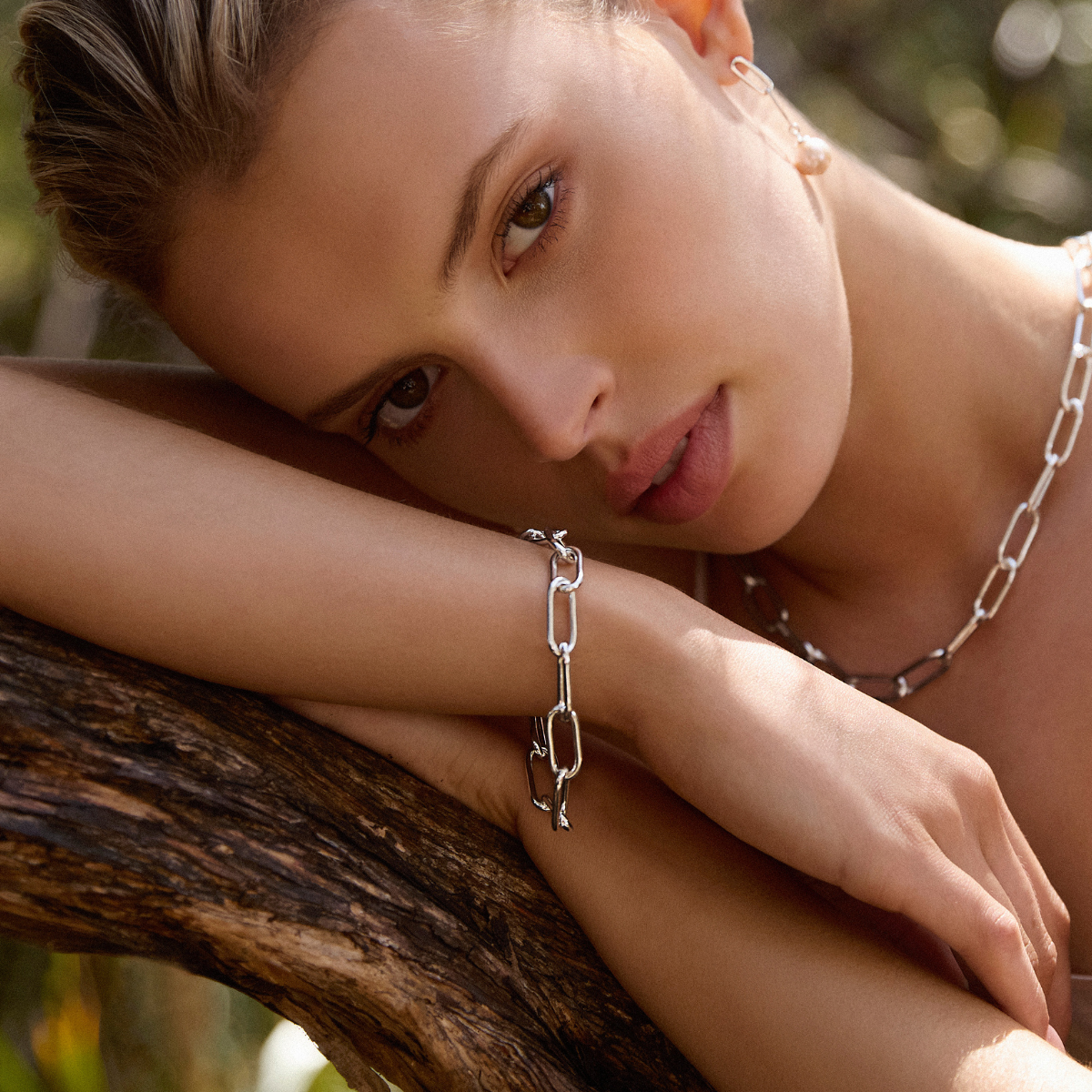
Which is better sterling silver or solid silver?
Have you noticed that some jewellery descriptions say sterling silver while others say solid sterling silver? So which is better, sterling silver or solid silver? Quite simply, they’re both exquisite.
Solid sterling silver jewellery pieces tend to cost more as they use more sterling silver by weight. However, some jewellery designs can be formed using hollowed sterling silver tubing, for example. This tubing enables jewellery designers and silversmiths to craft lighter-weight pieces that are more comfortable to wear for longer.
Some of NAJO’s most iconic collectable designs are handcrafted from solid sterling silver, including the Spratling Bracelet, Awaken Ring and Garden of Eden Bangle.
Jo Tory, our Creative Director, also loves crafting pieces from sterling silver tubing because they’re more affordable without compromising quality and beauty (as they don’t use so much real sterling silver by weight). These lighter pieces are especially perfect for brides looking for ultra-comfortable minimalist designs with maximum impact.
Why buy sterling silver jewellery?
Is sterling silver good jewellery silver? It’s the best. Unlike other ‘silver-coloured’ metals, non-sterling silver or silver-coated brass, NAJO’s collection of sterling silver jewellery is durable, highly polished, relatively lightweight and easy to wear. It’s also much brighter and whiter than other precious metals such as platinum or gold.
Since 1986, we’ve been designing and handcrafting sterling silver bangles, rings, necklaces and earrings for individuals who want to express themselves while staying true to their personalities. Sterling silver is our luxurious metal of choice for rich storytelling.
Caring for sterling silver jewellery: your FAQs
Can you wear sterling silver every day?
Absolutely! Wearing your sterling silver jewellery every day keeps it looking polished and new. Because sterling silver is strong and durable, it withstands wear and tear, especially if you follow some simple rules about caring for sterling silver and avoid the following:
- Swimming, showering or doing vigorous exercise while wearing your sterling silver jewellery.
- Exposing your jewellery to cleaning agents or cosmetics such as foundations, perfumes, and hairsprays.
- Exposing your jewellery to excessive heat or prolonged periods of direct sunlight.
- Commercial silver ‘dip’ solutions – they’re unsuitable for cleaning hollow, oxidised, stone-set, pearl or plated jewellery and can cause surface deterioration.
- Wearing your delicate sterling silver jewellery designs on more than an occasional basis.
Can you shower with sterling silver?
We always recommend removing your sterling silver jewellery when showering for a few important reasons! Firstly, showering with 925 sterling silver jewellery exposes it to hot water and steam, which can oxidise the silver. This tarnishes and darkens it over time and risks reducing its lifespan.
Showering with sterling silver jewellery also runs the risk of your pieces collecting residues from hair products and soaps. Most importantly, you don’t want to lose your precious sterling silver jewellery down the drain (it’s happened to our customers many times)!
Does sterling silver turn black (known as tarnishing)?
Yes, all sterling silver tarnishes, especially when exposed to salt air, humidity and sulphur (found in rubber bands and some paper).
To prevent tarnishing, the best thing you can do is wear your NAJO necklaces, rings, bangles and earrings regularly (although not while swimming, showering or cleaning) and store them carefully the rest of the time. A dry, soft-lined jewellery box is ideal, and if your climate is humid, a small sachet of silica gel crystals can also help.
Check out our range of beautiful jewellery boxes here. NAJO sterling silver jewellery is anti-tarnished to help prevent oxidation and add to the metal’s naturally bright and glossy appearance.
Will sterling silver turn green?
Does sterling silver turn your finger green if you’re wearing a ring? On rare occasions, you may notice a green tinge underneath your ring where the sterling silver jewellery meets the skin. There’s a simple explanation!
Everyone’s skin has different chemicals for many reasons, including how much we sweat and the beauty creams or topical medicines we use on our skin. So if you notice a green mark on your skin under your ring, it’s because your skin and/or products have reacted to the tiny amount of copper in sterling silver used to strengthen the metal. The copper is blue-green in colour hence the residue on your skin. The green on ‘green fingers’ is neither harmful nor a sign that your jewellery is poor quality (it can happen if you’re wearing expensive fine jewellery too)!
Wondering how to get rid of the green stain on your finger? Simply remove your ring and wash your hands in warm soapy water. For stubborn green residue, apply a little rubbing alcohol to the area and immediately rinse your hands thoroughly (follow the rub’s instructions and don’t use it if you have any cuts).
How to stop your finger from turning green
- Make sure your jewellery is the last thing you put on in the morning and the first thing you take off at night. That way, you can avoid exposing your pieces to beauty products and creams.
- Always make sure your hands are dry before putting on your jewellery.
- Remember to remove your jewellery before showering or swimming!
- Store your jewellery well and follow our tips about caring for your jewellery.
How to store sterling silver jewellery?
When you’re not wearing your jewellery, we recommend storing it safely away from moisture, sunlight and air. Luckily, your NAJO jewellery arrives beautifully stored in our complimentary gift box, designed to protect your sterling silver.
Each box has a drawer with a soft two-sided microfibre pouch to keep your jewellery snug, safe and clean. Best of all, our boxes are 100% recyclable in keeping with our slow jewellery ethos. Our shop also has a collection of beautiful jewellery boxes for the best sterling silver protection.
How do I clean my sterling silver jewellery?
To clean your jewellery, wipe it with a soft silver polishing cloth or try a silver polish or foam, but avoid using silver dip. You can find Najo Jewellery Cleaner and Brush Sets and Jewellery Cleaning Cloths in our online shop.
For more information, visit our NAJO Jewellery Care Guide with helpful tips about caring for sterling silver jewellery, or get in touch with our fantastic team.
Trusted sterling silver jewellery online shopping
For almost 40 years, NAJO has empowered individuals with harmonious jewellery designs that make them feel stylish and beautiful. Our trusted and hallmarked sterling silver jewellery pieces are responsibly handcrafted by master silversmiths, stonecutters and artisans across the globe.
Whether looking for a stunning everyday contemporary piece or an exquisite bridal jewellery design, head to our online shop or find your local NAJO stockist here.
We hope you’ve enjoyed our Definitive Guide to Sterling Silver and look forward to seeing you in our beautiful sterling silver jewellery designs. Don’t forget to tag us @najojewellery on Instagram!











